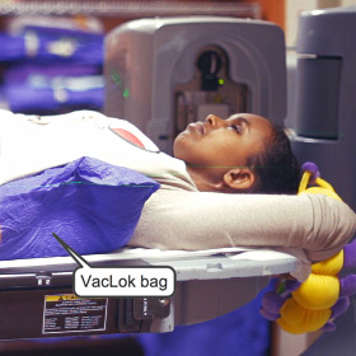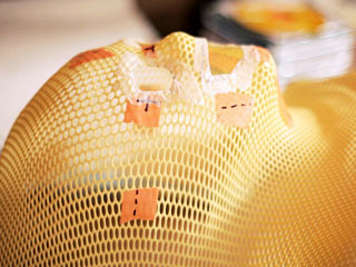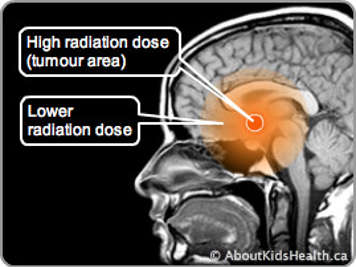What is radiation therapy?
Radiation therapy has been used as part of cancer treatment for over 100 years. Radiation therapy uses a type of energy called photons to destroy cancer cells. The radiation used is similar to that used in X-rays, which take a picture of your bones, but it is of a much higher energy. It cannot be seen or felt.
These high energy X-rays are delivered using a special machine that focuses the X-rays so they are accurately aimed at your tumour or cancer cells. Radiation therapy can be a part of treatment for many different types of cancers. It is useful because it can destroy cancer cells, so it can be used to:
- shrink a tumour before another treatment such as surgery or chemotherapy
- kill cancer cells that might still be in the body after surgery or chemotherapy
- relieve symptoms of cancer such as pain
How does radiation work to treat cancer?
Radiation destroys the cancer cells by damaging their inner structure (DNA). This stops them from dividing. When exposed to radiation, the cells eventually die when they try to reproduce and are then absorbed into the body. Healthy cells have DNA too, so unfortunately they can also be damaged by radiation. But unlike cancer cells, healthy cells can repair some of the damage and survive or be replaced by healthy cells nearby.
Radiation therapy is often used to treat cancer along with chemotherapy, surgery or both.
The radiation team
Radiation therapy is done by a team of people.
- The radiation oncologist is the doctor who is specially trained to treat cancer using radiation. They work with the oncologists to manage your cancer. Their role is to prescribe the radiation, supervise treatment and evaluate how the treatment is affecting you.
- The radiation therapy nurse or radiation therapist co-ordinator co-ordinates the radiation treatment. They are specially trained to help you handle any side effects. The nurse or co-ordinator will supervise your care each day, keep you informed about your radiation and support you and your family throughout the treatment.
- The radiation therapist is specially trained in giving radiation treatment. They work closely with the radiation oncologist and the rest of the team to design, plan, prepare and give you radiation. They will actually operate the machine that delivers the radiation therapy every day.
Before you start treatment, you and your parent/caregiver will meet with the team. They will explain your radiation treatment plan and will ask you and/or your parent to sign a consent form.
Planning radiation therapy
After the initial visit with the radiation team, you will be booked for a scanning appointment. As part of this appointment, you will have a CT and maybe an MRI scan at the radiation centre to help the team plan the radiation treatment. The scan helps your radiation team decide the best treatment position for you to lie in during your treatment and locate the exact area to be treated. The scanning session can take about an hour.

You may require a special bag (VacLok) to lie on during the scan and treatment. You will lie on the bag while air is sucked out of it. As this happens, the bag will be moulded to form the shape of your body. Before the scanning session is over, small permanent tattoos (the size of small freckles) are put on your skin. The tattoo is made with a special dye, which is applied by scratching the skin with a needle. These tattoos and the shaped bag will be used when you go for radiation treatment to make sure you are in the same position every time.

If you are having treatment above the shoulders, you will need a plastic mask to keep your head in the same position during each treatment. The mask will be made on the same day, before the planning CT.
To make the mask, a sheet of plastic with lots of holes is placed in a warm bath so that it becomes wet like a face cloth. The plastic sheet will be placed over your face to create your own personal mask.
Radiation treatment doses

Your radiation oncologist will decide how much radiation it will take to treat your cancer. This amount is called the dose. Radiation is generally given in many small doses (fractions) over a period of several weeks. The number of fractions you have will add up to the total dose of radiation you need.
The daily amount of radiation and the length of treatment depend on the type of cancer you have and its location. Your treatment will require that you attend the treatment unit every day for a period of days to several weeks. You won’t need to stay overnight in the hospital for treatment.
Receiving radiation treatment
Receiving radiation is like having an X-ray. There is no pain or sensation, but it involves lying still for a few minutes. Although you will not see or feel anything during the treatment, the machines may make clicking or whirring noises.
Each time you come in, you can expect to spend 15-30 minutes each day in the treatment room. Most of this time is spent positioning you for this treatment. The actual treatment time is about 5-10 minutes. Parents/caregivers and therapists must leave the room before the machine is turned on, but they are able to watch you on a TV monitor and communicate with you through a speaker system if needed. You may want to bring music to listen to during treatment.
Once a week you will be seen by the radiation oncologist for general monitoring and to discuss any concerns you may have. It may help you to write down your questions and bring them with you. The radiation nurse co-coordinator and radiation therapists will be available every day to respond to any concerns or questions you may have.






